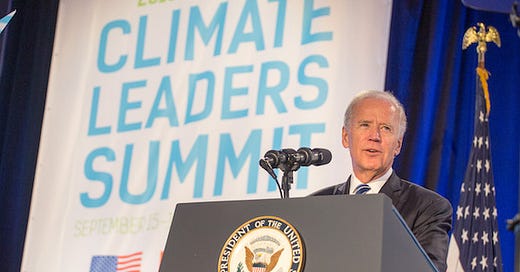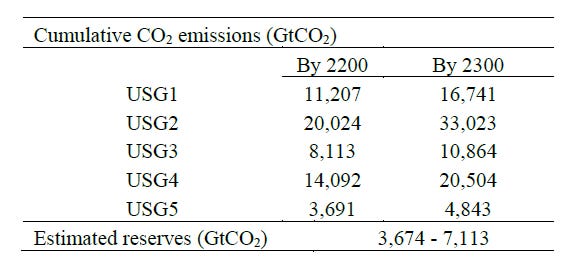The Biden Administration Just Failed its First Science Integrity Test
Pricing carbon makes good sense but should not come at the expense of scientific integrity
Last week the Biden Administration announced “a return to science” in the form of “evidence-based estimates of the benefits of reducing climate pollution.” Technically, such estimates are called the social cost of carbon (SCC). The SCC is a quantification of the economic consequences of the emissions of carbon dioxide for use in benefit-cost analyses of proposed Federal regulations.
Before proceeding, let me put my cards on the table. First, a price on carbon makes very good sense, and is absolutely necessary for deep decarbonization — something I’ve argued for decades. Second, scientific integrity is non-negotiable, even in the context of noble causes like dealing with climate change.
Unfortunately, the U.S. government’s estimates for the social cost of carbon have compromised scientific integrity. With its SCC announcement last week, rather than a “return to science,” the Biden Administration has continued a long-standing charade that not only violates its claim to uphold scientific integrity, but leaves its carbon price extremely vulnerable to legal challenge. Before taking a look at the fatal flaw in Biden Administration’s social cost of carbon, let’s take a quick look at where it came from.
In 1993 President Bill Clinton issued an executive order requiring that federal agencies when proposing an economically significant regulation, “shall assess both the costs and the benefits of the intended regulation and, recognizing that some costs and benefits are difficult to quantify, propose or adopt a regulation only upon a reasoned determination that the benefits of the intended regulation justify its costs.” Although costs and benefits may be difficult to quantify, the executive order requires that regulatory decisions must be based on “the best reasonably obtainable scientific, technical, economic, and other information concerning the need for, and consequences of, the intended regulation.”
Flash forward to 2008, when a federal court ruled that the U.S. Department of Transportation was in error in conducting a benefit-cost analysis when it assigned a value of zero to the economic consequences of carbon dioxide emissions, concluding, “while the record shows that there is a range of values, the value of carbon emissions reduction is certainly not zero.” This judgment meant that the government would subsequently need to develop a defensible estimate of economic consequences of carbon dioxide emissions. Subsequently, in 2009 the Obama administration established an “interagency working group” (IWG) to develop estimates of the SCC, “to ensure that agencies were using the best available science and to promote consistency in the values used across agencies.”
Soon after, in 2010 the IWG estimated the SCC at $26 (in 2007$ for 2020) per ton of carbon dioxide, and following several updates, in 2016 set the value at $42 (in 2007$ for 2020) per ton in 2016. In March, 2017, the Trump administration disbanded the IWG and issued a new and much lower estimate for the SCC of $7 per ton (in 2018$ for 2020). Last week the Biden administration restored the final estimate of the Obama administration (now $51 per ton in inflation-adjusted 2020$ for 2020), as an “interim step” to issuing updated estimates sometime in the next year.
The current SCC is science-y — it has the appearance of rigor, sophistication and is calculated under a mindbogglingly complex set of methods. But looking behind the curtain reveals that it is much closer to quantification theater than to scientific rigor. The current SCC would appear to be unlikely to survive legal challenge, and even worse, indications are that the forthcoming update of the SCC may be similarly indefensible. Let me explain.
The academic literature has many valid critiques of the methodologies for estimating a SCC as well as critiques of the very idea of a SCC. The former typically focus on technical issues involved with things like setting economic discount rates and creating damage functions that relate temperature increases to economic consequences. The latter often emphasizes the fact that there can be no empirical or objective basis for many of the assumptions that must be made to produce a estimate of the SCC.
As a result of the many approaches to SCC methodologies, the range of available estimates spans many orders of magnitude. Richard Tol, of the University of Sussex and whose work is central to the IWG methodology, observes that “published estimates [of the SCC] range from -[$]771/tC to +[$]216,035/tC. Research cannot reduce the span of credible estimates by much, as the future is uncertain and ethical parameters are key.”
Tol is correct, but here I will emphasize a much more fundamental and immediate problem with the Biden administration’s current estimates — it is based on climate scenarios that are not just badly out of date, but reflecting a set of fictional worlds. Consequently, any SCC derived from such implausible scenarios simply cannot be justified as reflecting “best available science and data.” The Biden administration’s touting of the scientific quality of the estimate invites a legal challenge.
And now to the fatal flaw — In order to estimate future damages resulting from the emissions of carbon dioxide into the atmosphere, plausible estimates of how that future might unfold are necessary. The IWG based its original 2010 SCC on eight different scenarios of the climate future, developed more than a decade ago. Four of the scenarios were to represent different visions of how the future might unfold in the absence of climate policies (called “business as usual”) and four others were combined into a single scenario to reflect a future with climate policy. These five scenarios looked out to 2100, so the IWG extended them to 2300 using a range of assumptions. Each of the five scenarios is weighted equally in estimating the SCC.
These outdated scenarios have never been updated in the IWG methodology. All of them, including the policy scenario, envisage enormous emissions of carbon dioxide from the burning of fossil fuels to 2300. None of these futures are remotely plausible, in fact they are laughable.
A simple exercise will illustrate the absurdity.
Many nations around the world have committed to achieving net-zero carbon dioxide emissions by mid-century. This will be a difficult and worthwhile challenge, to be sure, and it is not currently the global trajectory. So as a thought experiment let’s assume instead that the world achieves net-zero carbon dioxide in 2100 and 2200. In these two cases, the former implies that the world emits an additional ~1,400 +/- gigatons of carbon dioxide before reaching net-zero, and the latter implies ~3,150 +/- gigatons.
We can compare the ~1,400 and ~3,150 gigatons of cumulative future carbon dioxide emissions to the assumptions of cumulative emissions underlying the Biden Administration’s current estimate for the SCC, shown in the table below for each of the five “USG” scenarios (the first four are “business as usual” and the fifth is the “policy” hybrid).
The scenarios underlying the SCC estimates of the Biden administration envision cumulative carbon dioxide emissions that are far, far in excess of any plausible current expectation about the future. In fact, to even approach these massive amounts of cumulative emissions, the world would have to make it a policy goal to burn as much coal as possible over the coming centuries. That seems unlikely.
The difference between plausible expectations for future emissions and the imaginary worlds of the scenarios underpinning the IWG SCC is important because most of the cumulative damage projected due to climate change occurs well after the end of the 21st century. For instance, 55% of total damage estimated by the integrated assessment model with the largest damages from carbon dioxide occurs from about 2100 to 2300 (under a discount rate of 3%).
Put another way, more than half of the Biden’s administration’s estimate of the social cost of carbon is based on damages that occur under temperature changes of 3 degrees Celsius at the end of the current century to greater than 9 degrees Celsius by 2300. According to the Climate Action Tracker, the world is presently on track for a temperature increase of about 2.9 degrees Celsius by 2100, and “the Paris Agreement’s 1.5°C within striking distance.”
If the world economy does not actually emit into the atmosphere tens of thousands of gigatons of carbon dioxide, as envisioned by the IWG, then the majority of the IWG SCC estimates are simply imaginary — setting aside all other methodological issues that might be raised.
In 2017, the National Academy of Sciences recognized that many aspects of the IWG methodology were dated or unsupported, and recommended a range of actions to update and improve the SCC estimate. In response, the Biden administration has appropriately committed to “evaluate and incorporate the latest climate science and economic research and respond to the National Academies’ recommendations as we develop a more complete revision of the estimates for release within a year.”
This is ostensibly good news. But there is potentially more trouble ahead, even if the outdated scenarios are updated to take into account plausibility. The Biden administration is relying “in particular” on a consortium of researchers whose “cookbook” for estimating future damage from climate change relies on using another implausible, extreme scenario (called RCP8.5). If the IWG grounds any part of its forthcoming updated methodology in outdated scenarios — such as embodied in newly developed damage functions — it will again produce a SCC that looks like science but would be more accurately described as fiction.
The social cost of carbon will always be a reflection of values that are potentially obscured or hidden by quantification (a feature or flaw of benefit-cost analyses, depending on your view). However, there are better and worse ways to develop quantitative estimates of the social costs of carbon. Some of these ways are defensible in terms of scientific integrity. Others are not.
The current approach and estimate employed by the Biden administration is simply not defensible. An updated SCC by the Biden administration should meet widely held standards of scientific integrity, as well as advance climate policy goals. The good news is that furthering climate action while upholding scientific integrity is readily achieved.






I wish I had this information when I was preparing comments for New York's value of carbon guidance (https://wp.me/p8hgeb-yo).
I will use this in the future though - thanks.
One question:
Does the fraction of total damages occurring from 2100 to 2300 change using a different discount rate?
Roger Caiazza
The US is certainly not the only country on the planet emitting CO2. It emits around 13% of the planetary total. In making estimates for future centuries what assumptions must be made about what courses of action will be taken by each or all of the countries representing the remaining 87%, for decades from now? And on what empirical basis can one such assumption determined to be a better forecast of the future than another?